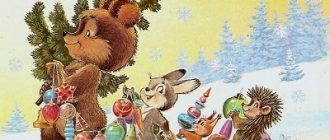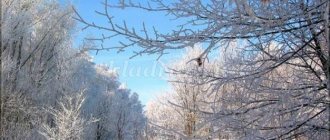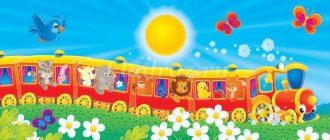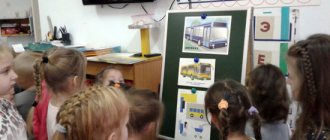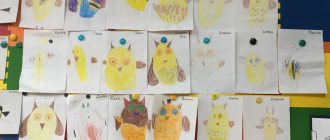Along the paths of the rainbow
Abstract of GCD on the formation of elementary mathematical concepts in the senior group
Target
: generalization and consolidation of knowledge among children of the senior group on the topic of material for the school year.
Educational tasks
: consolidate quantitative and ordinal counting from 1 to 10 and back, understanding the number series;
consolidate skills in comparing the number of objects; consolidate the ability to navigate on a sheet of paper; continue to form an idea of the table. Developmental tasks
: train mental operations;
develop spatial and logical thinking, attention, speech, curiosity, emotions, interest in independently solving problem situations. Educational objectives
: to cultivate mutual assistance, independence, determination, perseverance.
Materials and equipment
: projector, presentation, ball, easel, paper flowers with tasks, cards with numbers, geometric bodies (cube, ball, prism, cone, pyramid, parallelepiped, cylinder);
white dish, Skittles candies, warm water for experiment, musical accompaniment: “Rainbow Song” lyrics. and music T. Shikalova. Handouts
: cards for comparing numbers, cards with passports of geometric bodies, a set of numbers, table cards, geometric shapes (3 blue triangles, 3 pink squares, 3 green circles).
Progress of activities
Educator
: Guys, can you solve riddles?
Children
: Yes.
Educator
: Then listen carefully.
The rain is over. Having parted the clouds, a ray of sunshine made its way to us. And literally before our eyes, the Bridge appeared in heaven. Multi-colored arc - This is... ( Rainbow
.)
Look at the screen. What a beauty! What could be brighter than a rainbow?
What a miracle, miracles. The rainbow came to visit, And brought paths. And the paths are not simple. They are all magical, colorful. Whoever walks along the paths will move on to the preparatory group!
Guys, do you want to go to the preparatory group?
Children
: Yes.
Educator
: Oh, what happened?
The rainbow has disappeared! How do we now move on to the preparatory group? Where did she disappear to? ( Children's answers
.) I wonder if there is some secret here?
Look carefully at the screen! I think I guessed where the rainbow hid! And you?! ( Children's answers. The teacher draws the children's attention to the flowers growing in the clearing
.) In order for the rainbow to appear again, you need to complete math assignments.
They will be very difficult. So guys, be careful! Ready? ( Yes
.) Let's try.
Remember how many colors are in the rainbow? Name them. ( Children's answers
.) They all stand next to each other in strict order. Which flower will we pick first?
Children
: Red.
( The game exercise “Match the numbers” is carried out
.)
Educator
: A strange case, a rare case, Numbers in a quarrel, Here they are! Not one of them wants to stand with their neighbor, We need to reconcile the numbers. And restore their order"
How can you reconcile the numbers? What needs to be done to get them in the right order? ( Children's answers
.) That's right, you need to build a number series from 1 to 10. Take the numbers lying on the table and put them in the correct order.
Well done guys, you completed the task and we have our first rainbow carpet - red. ( A rainbow path appears on the screen
.) What color will the next flower be?
Children
: Orange.
( The game exercise “Name the neighbors of the numbers” is being carried out. The teacher shows cards with numbers.
) Well done, guys, and you did an excellent job with this task.
And we have another track - orange. ( A rainbow path appears on the screen
.) The next flower will be...?
Children
: Yellow.
( A ball game is played in the “Days of the Week” circle. The teacher asks questions
.)
Educator
: How many days are there in a week?
List the days of the week in order. What days are days off? Name the day of the week before Wednesday. Name the day of the week between Thursday and Saturday. What day of the week is it today? ( Children's answers.
) Everyone completed the task and we got another path - yellow.
Choose the next flower. What color is it? ( Children’s answers. The game exercise “More - less - equal” is carried out.
) Compare the number of objects using the signs “<”, “>”, “=”.
Now we will work in pairs. ( Children complete the task.
) Great! Another rainbow path has appeared. What color will the next flower be?
Children
: Blue.
Educator
: That's right (
working at tables in pairs
). Guys, come to the table. What's on the table?
Children
: Figures.
( A game exercise is carried out in pairs “I lost my passport
.”)
Educator
: Let's remember their names.
( Children's answers
.) These figures lost their passports.
But how can we help them? Choose one figure for yourself. The remaining figure will be mine. Listen to the hint. I'll take a card and a piece. Since this figure is three-dimensional, I will look at it from all sides. What does this figure look like from the side? Above? From below? ( Children's answers
.) Let's now try to find her passport among others.
When you find the passport, place the figure on it. Hooray! We now have a fifth blue track. ( Physical minutes are held with musical accompaniment.
) How many flowers are left in the clearing?
What color will the next flower be? ( Children's answers. In the next task, the teacher orally pronounces the text of the problem
.)
The hedgehog brought three apples from the garden. He gave the most rosy thing to Belka. The squirrel happily received the gift. Count the apples on the hedgehog's plate. ( Children count and name the answer. The teacher says the next problem
.)
Well done boys! All problems were solved correctly. Our rainbow is getting wider and brighter! A blue path has appeared! We have one last flower left. Which?
Children
: Violet.
( Game exercise “Fill in the table
.”)
Educator:
You have geometric figures and a table on your tables.
You need to fill out the table correctly. Listen carefully. Place a blue triangle in the upper left corner. Place a blue triangle in the center of the table. Now fill in the empty cells with figures so that they are not repeated either in the rows or in the columns. Happened? Let's check. Well done boys! The last path of the rainbow appeared - purple. Look how the rainbow is shining again! For your efforts, I have prepared a small surprise. ( Finally, a Rainbow experiment is performed using Skittles and water
.)
Lyubov Bukhalova, teacher
at MBDOU “Kindergarten No. 251”, Barnaul, Altai Territory
Work program for the Rainbow program, senior group.
the child is capable of volitional efforts, can follow social norms of behavior and rules in various types of activities, in relationships with
adults and peers, can follow the rules of safe behavior and personal hygiene;
the child shows curiosity, asks questions to adults and peers, is interested in cause-and-effect relationships, and tries to independently come up with explanations for natural phenomena and people’s actions; inclined to observe and experiment. Has basic knowledge about himself, about the natural and social world in which he lives; is familiar with works of children's literature, has basic understanding of wildlife, natural science, mathematics, history, etc.; the child is capable of making his own decisions, relying on his knowledge and skills in various activities.
Based on the results of mastering the Rainbow Program, the child:
has physical development corresponding to age normative indicators; he has developed basic physical qualities, the need for physical activity and movement; shows individual interest in some form of physical activity (sports, choreography);
has basic cultural and hygienic skills; implements them independently and consciously in his life;
understands and shares the value of a healthy lifestyle, knows how to follow basic rules for protecting one’s own health and the health of others, has an age-appropriate understanding of safe behavior in everyday life, in nature, among strangers; cognitively active, inquisitive, able to independently research, experiment, find a variety of information in various sources - books, encyclopedias, films, and also knows how to ask adults questions of interest; has its own area of interest;
is independent and at the same time knows how to turn to adults for help;
interested in learning and improving one’s own competence in various fields of activity, has the universal prerequisites for educational activities: the ability to work according to rules and patterns, listen to an adult and follow his instructions;
emotionally responsive, capable of empathy and sympathy, responds to the emotions of loved ones, empathizes with characters when perceiving works of fiction, theater, cinema, visual arts, music, as well as the beauty of the surrounding world, nature;
sociable, able to adequately use verbal and non-verbal means of communication, able to conduct a dialogue and express his thoughts using monologue speech; knows how to negotiate with peers, plan joint activities, has cooperation skills; has a communication style with adults and peers and can change it at will;
MAGAZINE Preschooler.RF
Summary of an open educational lesson with elements of experimentation in the senior group on the topic “Seven Colors of the Rainbow”Goal: to introduce children to the natural phenomenon - the rainbow, with all the colors of the rainbow and the sequence of their arrangement; develop speech, use acquired vocabulary in coherent and expressive speech; develop children's curiosity, cognitive interest in the process of experimentation, and the ability to draw conclusions.
Objectives: develop the ability to feel the beauty of nature and express your emotions; develop curiosity, color perception, speech development. Arouse interest in the image of a rainbow. Develop a sense of color. Provide basic information on color science. Foster an aesthetic attitude towards nature. Independently describe your impressions of music and the image of a rainbow, creatively reflect your ideas about beautiful natural phenomena. To introduce children to the properties of natural materials, to stimulate the development of independence and responsibility.
Enrichment of vocabulary: rainbow, seven-color, arc, researchers, laboratory.
“Rainbow” poster , a set of colored ribbons, a musical recording, pictures or slides depicting the sun, rainbow, landscapes, portraits of animals, plants of all seven colors of the rainbow; for experimenting: a small bowl, a mirror, a white sheet of paper, a jar, an apron.
Progress of the lesson:
The teacher invites the children to think and talk about what joy is. After a short, but very free and emotional conversation, tell the children that in ancient times in distant Egypt, people called the sun by the name of Ra, therefore the words joy and sun are similar in meaning. Ask the children what words they can remember that sound similar to “joy” , and read a work about a rainbow, and before that ask a riddle:
What kind of miracle is this rocker hanging after the rain? Very bright, colorful, and how beautiful! Multi-colored solar arc……… (rainbow) Educator: that’s right, children, this is a riddle about a rainbow. What is a rainbow compared to? (a rainbow is compared to a miracle - a rocker, an arc). What does it say about the color of the rainbow? (it is multi-colored, sunny).
Physical education moment.
Oh you, rainbow - arc, You are tall and tight! Don't give me some rain, give me a bucket.
For children to take a walk, For calves to jump, We need the sun, a bell! (Russian folk nursery rhyme)
Accompanied by “Seasons” P.I. Tchaikovsky demonstrate slides or pictures depicting the sun, rainbow, landscapes, portraits of animals, plants of all seven colors of the rainbow (red berries, orange fox, yellow flowers, green grass, blue sky, blue water, purple mountains, etc.). The teacher asks the children to name these colors and shades.
Educator: we know that in a wonderful natural phenomenon you can see seven colors at the same time - this is a rainbow. Rainbow is an atmospheric phenomenon. It can be observed in the sky in the warm season, when there is a fine, frequent, warm rain, and at the same time the sun is shining through the clouds; The sun's rays pass through the raindrops and a rainbow is formed. Rainbows occur when sunlight illuminates water droplets in the air after rain.
Hey rainbow! Do you know or not who your dad is? Certainly! Sun light. Do you know your mother?
Who is she? Heavenly water! More precisely, rain... (E. Tarlapan)
Educator: How many colors does the rainbow have? (children answer: seven). Do you know the colors of the rainbow, and do these colors always appear in a certain order (or do new colors appear in the rainbow each time in a random order)? (Children answer.) I show the visual aid “Rainbow” and ask them to name the colors, starting from the top arc. I put away (close) the manual or model and ask you to remember the order of the colored arcs. Let us remember the humorous text with you: “Every hunter wants to know where the pheasant sits” to remember the order of the colors in the rainbow. Each word in this phrase begins with the letter that begins the word that represents the color of the rainbow. the first word "every" begin with a letter? (j), so what is the first color in the rainbow? (red). The second word in this magical phrase is “hunter” , what letter is this word? (with the letter o), and what is the color for the letter “o” ? (that's right, orange). So we analyze each word sequentially, highlight the letter and remember the colors: (red, orange, yellow, green, blue, indigo, violet). How many colors are there in a rainbow? (seven).
Educator: how can you “decipher” the word “rainbow” ? (children's answers: solar arc or arc and the sun, or arc of joy, joyful arc).
Educator: how many of you have seen a real rainbow? Tell us about this joyful event (where was it, when, was it raining or was the sun shining at that time, what feelings did the rainbow evoke in you who saw it?) Children's stories.
The game "Rainbow"
Educator.
Children in the meadow in the summer drew ra-du-gu. They drew and drew, and then suddenly they began to argue: What flowers is it made of so beautifully? (Each of the children raises their ribbon and names its color.)
Children. Green! Orange! Violet! Blue! Green! Blue! Red!
Educator. Yes, the task is not easy - the colors are mixed up! The children began to draw rainbows together again.
And no longer confuse the colors - call them in order!
Children. Red! Orange! Yellow! Green! Blue! Blue! Violet! (Children make a rainbow out of ribbons.)
Educator: What a wonderful, beautiful rainbow you have created!
Educator: why does a rainbow appear? Do you want to know?
— Let’s name the properties of water together. Water refracts light and reflects light rays.
- Let's remember what color is sunlight? (Consists of 7 spectrum colors)
When a ray of sunlight hits water, it is refracted. And we see all the colors of the solar spectrum. And this is what we call a rainbow.
There are a lot of water droplets in the air. What color guys are they? (white) And in shape? (teacher shows a prism) About 300 years ago, scientist Isaac Newton passed the sun's rays through a prism. He discovered that white is a “wonderful mixture of colors” (the teacher shows pictures of a rainbow).
Now let's go to the laboratory and begin our research. Before conducting experiments, I remind children about safety precautions when working with objects. Children put on aprons and come to the table on which there are small bowls of water.
Experiment No. 1. Purpose: to introduce children to a natural phenomenon - a rainbow.
Educator: Do you want to try to catch a rainbow? (the experiment works if the sun is not high). Take small bowls and fill a little more than half of the water. Place the mirror in the water at an angle. Catch a ray of sunlight with a mirror and direct it to the wall. Rotate the mirror until you see all seven colors. Children perform an experiment.
Physical education minute.
1. Rainbow
A rainbow hangs in the sky (draw a rainbow in the air) It makes the kids happy. (stretch up and wave your hands) From it, like from a slide, (lower your hands down) Egorka, the rooster, the Cat, the pig and I are riding. (bend fingers on hand)
2. Colorful colors.
If everything in the world were the same color, (Rotational movements of the head.) Would it make you angry? Or would it make you happy? (Tilts the head back and forth.)
People are used to seeing the world in white, yellow, blue, red. (Hands on the belt, body tilts left and right.) Let everything around us be Amazing and different! (Jumping in place on the left, right, two legs.)
Experiment No. 2. Educator: to see a rainbow, fill a jar with water, place it on the windowsill from the inside or on the edge of the table next to the window. Place a white sheet of paper on the floor, on the shadow of the jar, and watch a rainbow appear on it.
— Thank you guys for participating in the experimental activities.
Now we know that a rainbow is created when a ray of sunlight passes through drops of water, the light is divided into seven colors - red, orange, yellow, green, blue, indigo and violet.
At the end of the experiment, he asks the children what the word “rainbow” ?
(children's answers).
— What is an arc? What is she like? (children's answers).
Lesson summary: Children correctly distinguish and name the colors of the rainbow sequentially. They can explain what a rainbow is and why it appears.
List of used literature:
- “From birth to school” program of education and training in preschool educational institutions, edited by N.E. Veraksy, T.S. Komarova, M.A. Vasilyeva M., Mosaic - synthesis, 2011.
- “The Color of Nature” by T.V. Shpotova, E.P. Kochetkova M., “Enlightenment” 2005.
- Internet resources (a riddle about a rainbow, experiments - experimentation).
| Next > |
